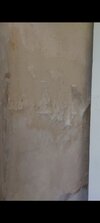- Joined
- 3 Jan 2024
- Messages
- 1
- Reaction score
- 0
- Country

Hey all,
I bought a Victorian terraced house 3 years ago and a year ago efflorescence started occurring in a horizontal line in my hall. I am at a loss though about what's causing it The wall is a shared wall with my neighbour and is solid. I had got it covered in lining paper before but have since stripped it and it's still occuring. I've checked the roof inside and bedroom above and no signs of damp, I've asked the neighbours and they had a tiny amount of it but it's now gone, they have a radiator on their side so it's not damp their side. It's only in the centre on the wall so not rising damp and I've looked at the outside of the house and the pointing seems ok. I'm baffled, any suggestions most appreciated!!

I bought a Victorian terraced house 3 years ago and a year ago efflorescence started occurring in a horizontal line in my hall. I am at a loss though about what's causing it The wall is a shared wall with my neighbour and is solid. I had got it covered in lining paper before but have since stripped it and it's still occuring. I've checked the roof inside and bedroom above and no signs of damp, I've asked the neighbours and they had a tiny amount of it but it's now gone, they have a radiator on their side so it's not damp their side. It's only in the centre on the wall so not rising damp and I've looked at the outside of the house and the pointing seems ok. I'm baffled, any suggestions most appreciated!!

